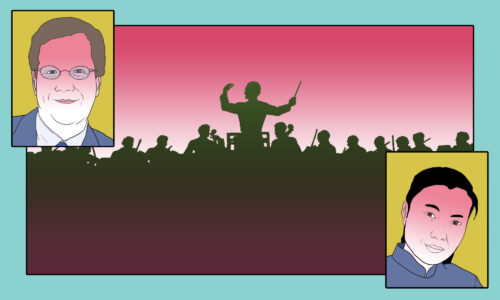Below is a complete transcript of the live Sinica Podcast with Gerard DiPippo.
Kaiser Kuo: Welcome to the Sinica Podcast, a weekly discussion of current affairs in China, produced in partnership with The China Project. Subscribe to Access from The China Project to get, well, Access. Access to, not only our great daily newsletter, but to all the original writing on our website at thechinaproject.com. We’ve got reported stories, essays and editorials, great explainers and trackers, regular columns, and of course, a growing library of podcasts. We cover everything from China’s fraught foreign relations to its ingenious entrepreneurs, from the ongoing repression of Uyghurs and other Muslim peoples in China’s Xinjiang region, to Beijing’s ambitious plans to shift the Chinese economy onto a post-carbon footing. We also talk about balloons. It’s a feast of business, political, and cultural news about a nation that is reshaping the world. We cover China with neither fear nor favor.
I’m Kaiser Kuo, coming to you from Chapel Hill, North Carolina.
They’re calling it Balloon-gate, which, for me at least, captures some of the weirdness and the absurdity, the hyperbole, the hyperventilating, the at-once farcical and serious and tragic nature of this whole affair that began Wednesday when people in Billings spotted an enormous balloon in the big skies of Montana. On Thursday evening, NBC came out with a claim that it was a Chinese balloon, and then the Pentagon confirmed soon afterward, and were calling it a Chinese spy balloon. Watching everyone opining about the whole thing on Twitter over the next 48 hours or so, and thinking about who I should get on the show to talk about this, I quickly settled on Gerard DiPippo, who is a senior fellow with the economics program at the Center for Strategic and International Studies, CSIS, in D.C.
Gerard was a Deputy National Intelligence Officer for economic issues at the National Intelligence Council, where he led the IC’s economic analysis of East Asia. He also was a senior economic analyst at the CIA, focused on East Asia, South Asia, and global economic issues. Gerard was in the thick of it through this whole balloon thing and had what I thought were some very valuable perspectives, but also some funny-ass tweets like, “this must have been what waiting for the moon landing was like, only much dumber.” So, Gerard, thanks for making the time on such short notice, and welcome to Sinica.
Gerard DiPippo: Thank you for having me. Long-time listener, first-time caller.
Kaiser: You’re no caller, man. I called you. Anyway, I am going to try to keep this episode really short and get it out right away because it’s so in the news, but let’s jump right in. Let’s start with what we can just say factually that isn’t in dispute, and for which there’s ample actual evidence beyond the Pentagon, just saying, they know something with confidence. Where would you start? What do we absolutely know?
Gerard: Well, both sides have admitted, or said, that the balloon is Chinese. The MFA said that, so I think we can treat that as fact.
Kaiser: Absolutely.
Gerard: It is a fact that Beijing essentially apologized in diplomatic speak by saying “regrets” and claiming force majeure, which is a legal term, meaning essentially like an act of God. They claimed it was a meteorological balloon, or sorry, mainly meteorological balloon that had drifted off course because of the way the trade winds work. That is at least their claim. I would say another factual point is that the U.S., the State Department postponed Blinken’s visit, and as of, at least the statements coming out on Friday, it was basically acknowledging the statement of regret. So, more or less acknowledging the so-called apology, but basically saying it was inappropriate for Blinken to go under the circumstances given the violation of U.S. sovereignty. And in fact, that it was a violation of U.S. aerial sovereignty is not really in dispute.
I mean, the Chinese don’t really dispute that either. They’re just saying that the U.S. overreacted. And the other fact is that the United States military shot down the balloon on midday Saturday off Myrtle Beach, apparently, with an F-22, using an AIM-9X Sidewinder missile. And then, of course, Beijing has condemned that as being an overreaction. On the maybe slightly gray area side is whether it is a “spy balloon,” whether it has ISR capabilities — intelligence collection capabilities. In my view, I would treat this as a confirmed, say, high confidence assessment. Maybe not literally a fact, but the Chinese side has not acknowledged that.
Kaiser: Yeah. It gets a whole lot more complicated beyond that set of facts that you said. Before we get to the actual fallout from Pentagon’s announcement about the balloon, which, of course, was the cancellation of Anthony Blinken’s planned trip to Beijing, I want to ask you about precedent for this sort of thing, whether with China or with another state actor, and whether that was made public or kept quiet, or how previous administrations have responded to this sort of thing.
Gerard: Well, if you’re looking at, say, different examples beyond the balloon space, one maybe sort of precedent that comes to mind is the downing of a U.S. spy drone over Iran in 2011, where basically the Iranians used cyber hacking to take down a, I think it was an RQ-170. Within about three days, the U.S. acknowledged that it was what it was because you could see it, but also what it was being used for. There’s some precedent there, but if you’re talking about the balloons itself, one of the gray areas here, and it’s still, I think an open question is to what degree was this happening before? The statements coming out of the Pentagon suggest that they’ve only recently realized that there were incursions from similar balloons going back into the Trump administration.
They also made it seem that this was the first one that had penetrated as deeply and as long into U.S., or at least over the continental U.S., territory. But it doesn’t seem to be disputed, at least by other governments, like in South America and Taiwan and elsewhere, that there have been numerous sightings of similar balloons.
Kaiser: Right. Has the U.S. government produced so far any evidence that the Chinese claim that it was a meteorological or mostly meteorological research balloon is simply false? Have they shown that or will that only have to wait until they actually salvage the thing?
Gerard: I think you’ll get a clearer, say, publicly viewable demonstration once they recover the wreckage, which is in about 50 feet of water. They’ll probably have it recovered within the next few days. So far, the DoD statements have been based on their assessments. The wording of them is “quite high confidence.” I personally believe what DoD is saying, but I know not everyone does.
Kaiser: Sure. I mean, because the thing is huge, right? You presumably wouldn’t need something, apparently, as you’ve pointed out, and this is so consistent to across all media now. The measurement, apparently, for the size of a balloon or for its carriage is the bus or the school bus, right? This is either two or three school buses, as we’ve heard now. How many buses actually is it, Gerard? Presumably, the sheer size of the thing means that it wasn’t merely a research vessel, right?
Gerard: Yeah. So, it implies the payload, so there’s the balloon, obviously, right? And there’s the thing underneath it that it’s carrying. And that thing seemed quite large and heavy. And also, the United States can see that with better imagery than you can see with the naked eye. They had fighter jets up looking at it, I’m sure. And they were presumably also intercepting some of the communications that the balloon was transmitting.
Kaiser: Yeah. How likely is it that, if we accept that this was indeed a spy balloon, was it deliberately overflying the continental U.S.? I mean, I usually hold that when it’s between conspiracy and stupidity, bet on stupidity, and that’s why I’m still convinced that Belgrade in ‘99 really was a mistake. So, what are your thoughts as to why this happened? Is there a conspiracy behind it, or do you think that they did in fact lose control of a balloon or simply didn’t believe that the U.S. would raise this as an issue with them?
Gerard: I think that’s a sensible heuristic, particularly when dealing with governments. And then you also maybe want to apply Occam’s razor. So, what is the simplest explanation that’s consistent with the facts? We don’t know yet whether it was intended to enter the continental United States. It’s plausible to me that it went off course; that maybe they had built in some safeguards that were meant to move it elsewhere or down it, say, over Canada or something, and those failed. But it is noteworthy that the balloon was at least near several sensitive U.S. military sites. With regard to this one particular trajectory, I don’t really know, but it is possible to me that whoever launched it, let’s say the PLA, intended to use it to surveil those sites.
Kaiser: Yeah. No, it’s certainly plausible. But it’s also, as you say, equally plausible that they simply did lose control over… the controls aren’t imperfect, right? I mean, you can’t actually steer. It just sort of uses prevailing winds and it’s able to sense those and move up or down into wind currents as far as my understanding goes.
Gerard: So, this might be another point of dispute. The DoD said it is steerable. So, the literal word for steerable is dirigible, which is what balloons are called sometimes that they are steerable. They’re claiming it is. So, it’s not just an altimeter, right? So, it could also maybe be directed. It seems that the Chinese side is denying that claim and saying its just sort of drifting with the winds. I think we’ll get more details. Yeah.
Kaiser: I guess we’ll see soon enough. Yeah. So, what’s the best theory in your mind as to why the Pentagon made its knowledge of the balloon public? Was it just because it had been spotted by civilians and was all over social media? Or I mean, do they ordinarily make these sorts of things public?
Gerard: I think the theory that because it was spotted is plausible, but it may be incomplete. As I said, it appears, at least the Pentagon is claiming, that they are only sort of retroactively realizing, by going through the data, there were other near incursions, which might sound kind of strange, but actually is plausible with the way that a lot of data is collected. And these kinds of targets are slow-moving. It’s not like a jumbo jet or whatever. And it might just be something that might have looked routine, but they weren’t tracking. We’ll see. Another thing we need to clarify.
Kaiser: There are all sorts of theories about the timing of the balloon and the timing of the announcement by the Pentagon. And I confess that I was entertaining a few of my own. Like that, perhaps someone on one side or the other wanted to throw a spanner into the Blinken visit. What do you make of the idea that this was somehow deliberately timed, either the mission itself or the announcement of it by the Pentagon, and did they put it out perhaps so that they could avoid potential embarrassment during the meeting? If the meeting had gone ahead, there had been no public disclosure of the balloon and it had come out, that could have been a real political landmine, right?
Gerard: Yeah, I mean, I’ll go back to your earlier heuristic. I think the simplest explanation is that this might have been the first obvious detection and that other people had seen it. I would be a lot less confident in theories that there was some political or foreign policy motivation beyond what NORAD or DoD was saying. I think once people saw what… and they had scrambled fighters, the cat was out of the bag, so to speak.
Kaiser: Yeah. But what about from the Chinese side? Is it possible, I mean, you’ve heard all these theories about a rogue PLA unit. Again, I know you’ll probably dismiss that out of hand, but wanting to scuttle the meeting or to embarrass the Ministry of Foreign Affairs.
Gerard: On the Rogue PLA unit theory, that to me doesn’t make a lot of sense, I guess for at least two reasons. One is that under Xi, he’s gotten pretty clear control of the PLA. I don’t know what commander would have the audacity to sabotage something that the center clearly wants. I think Beijing actually wanted this visit to happen. If someone dared do that, they’re going to be punished. The other reason why it doesn’t make any sense to me is why? I mean, it’s not like either side was prepared to make major concessions. It’s not like this is some massive arms negotiation that the PLA is going to get the short end of the stick on. So, why would the PLA feel the need to do that? I think that doesn’t really make any sense.
What makes a lot more sense, and it’s just the simplest explanation, is that this was part of an existing program. There were many other balloons, at least in recent years, not just with the U.S. but elsewhere, released from China, maybe other locations for all we know, and that it was basically green-lit. That this is an operational thing that was underway and that maybe Xi and the leadership were aware of the program itself. It is a lot less likely to me that they would’ve approved of a specific overflight of the United States right before or during Blinken’s visit. There’s just no logic to me to do that. And it seems like some people are suggesting, “Oh, it’s kind of like a power move.” It just seems like a stupid strategy. And Xi strikes me as not that tolerant of egregious risks like that. To me, it’s like the Occam’s razor answer is whatever unit is launching these, thought they had clearance. It was part of the schedule. They didn’t realize, oh, they should have synced this with the MFA and the central leadership before doing so.
Kaiser: So Gerard, you argued on Friday and over the weekend that the Blinken visit should have gone ahead nonetheless. And then by this morning, you seem to have changed your mind about it, or at least you were moving in a direction that was definitely more sympathetic to the administration’s decision to postpone. You tweeted something about that this morning. So, we’ll get to that in a second. But let’s be clear about why you thought the administration indefinitely postponed the meeting in the first place. I mean, what was the thinking behind the postponement? Was it mostly fear of domestic political repercussions? And then maybe let’s talk about your initial position and why you seem to have shifted.
Gerard: So I think that the delay probably was mostly for political reasons. There is another hypothesis that there was a thought that it would’ve been distracting or overwhelming in the actual private discussions with the Chinese. I don’t really buy that. I mean, both sides can cater to their needs, and I don’t think either side wants to make this a major issue, at least in their private talks. So, why did they delay it? I think it’s probably the politics of anticipating that the timing of where it was going, when it was going to get shot down, and the fact that the State of the Union Speech is tomorrow is just too politically sensitive for Blinken to have gone now because it would’ve fed into the media firestorm in the U.S. Now, those focused on bilateral relations might find domestic political considerations frustrating, but that’s how the system operates, right?
In terms of my view of this, you’re right that as of Friday, my view was, look, well, let’s not make this a big deal. Let’s address it, but it shouldn’t derail the whole visit. And Blinken should proceed as planned. I have changed my view, I think, because I was maybe underweighting the political reaction on the U.S. side. And frankly, this is why you have different stakeholders at NSC meetings. Whatever you think of it, there are domestic political considerations. It seems to me that it probably would’ve sucked some of the oxygen out, at least in terms of the media. And I think there might be a better window before the two sessions in early March if we can move quickly to sort of get over the hump, at least this media cycle over the next week or two, and then proceed with the trip. I actually think that maybe the Biden administration made the right call by delaying. Again, they made it clear that this is not a cancellation, it’s just a postponement.
Kaiser: Right. What did you make of the media reaction in the U.S. and to the sort of general American reaction to it? What does it say about the state of the bilateral relationship and about popular attitudes about China?
Gerard: So, it’s natural to me that media would cover this. It’s an interesting story. I mean, we’re having a podcast on it. This is the second podcast I’ve done on this issue. My impression is that a lot of people were following the issue on sort of mainstream media. This is not just an inter-beltway issue. The fact that my mother has been texting me about it is a leading indicator that this has wide reach. I don’t know what the general perception is amongst the American public. I suspect most people, like me, were sort of just bewildered or thought it was mildly humorous that we’re making such a big deal about this. I think statements about the so-called hysteria on the U.S. side, I think, are really directed towards maybe certain members of Congress.
I think there have been a lot of commentators saying that the U.S. is overreacting, but this is a case where I think we need to be very clear in a distinction between the executive branch and the legislative branch. And in my view, the Biden administration is actually not overhyping it. I actually think they would like to move past this. It’s congress that has different incentives and they’re the ones that are being more hyperbolic. What does it mean for the broader state of U.S. relations? It just feeds into the existing sensitivity and paranoia. I don’t know how much people’s views about China will actually change because of this, but if anything, it’s going to marginally push I think the U.S. population to be more suspicious or hostile.
Kaiser: Yeah, yeah. No doubt. No doubt. So, do you think that Blinken’s Chinese counterparts, I mean Qin Gang, for sure, but also Xí Jìnpíng 习近平 himself and those around him, do you think they understand how this looked from here in the States and understood the domestic political pressures that Biden at least believed himself to be under? I mean, I can pretty easily imagine that Mike Gallagher, and Chris Smith, and Marco Rubio, and all these others would’ve just had a field day had Blinken actually gone ahead with the trip, but does Beijing get that?
Gerard: My guess is they do. I mean, they’re not going to say that privately or publicly, rather. Qin Gang was in D.C. He was a former ambassador. They’re not stupid. I mean, they can understand U.S. domestic politics. They’re probably not going to “blame” Biden or Blinken for what Congress is saying, right?
Kaiser: Right. That’s what I’m getting at. I mean, does this maybe understanding inform the relatively mild reaction in Beijing? I mean, maybe you wouldn’t share my characterization of it as relatively mild, but it seems to me that they haven’t flipped.
Gerard: Yeah, they haven’t flipped, but it is interesting that as of today, the Chinese media narrative is still that this is… it is Chinese, but it’s a weather balloon and it was just some errant winds, right?
Kaiser: Right.
Gerard: The risk of that is that, if and when the U.S. recovers the wreckage and it becomes incontrovertible that this was a surveillance device, that’s going to put them in an awkward position. I mean, they could have, in theory, denied it was Chinese at all. If they did not, I think they eventually would’ve lost that battle just because of data about telemetry. But they’re still sticking with their guns with, this is not a spy device narrative, which is… I should note is actually different than how the U.S. handled, say, the 2011 incident with Iran or the various U-2 incidences during the Cold War.
Kaiser: Which was how? What did we do with like Francis Gary Powers or with the 2011 spy drone?
Gerard: Yeah. Well, I mean, we admitted that they were on spy flights, but, of course, that’s because of the aircraft involved, right? People don’t know much about balloons. We’re all pretending to be balloon analysts now. But if you use a U-2, you know what that’s for. It’s literally a spy plane. People have asked me like, “Is there a slippery slope now? Beijing will claim that various aircraft or civilian when they’re not?” I think this really only kind of, but barely works for balloons. It doesn’t work for like a fighter jet or an obvious surveillance aircraft.
Kaiser: Yeah. And just from your understanding of Beijing’s reactions in these things, will Beijing be chastened by this or will they be emboldened in any way?
Gerard: I suspect they got the message, which is that at a minimum, if you’re going to keep doing these types of operations, they better not cross into our airspace. And I also think that if the U.S. were to do something equivalent, whether, say, a balloon or let’s say a drone, or another unmanned device that went over to Central China, I would bet the PLA would intercept it. And I think they get that.
Kaiser: Sure. Yeah. So, do you think this does lasting damage to the bilateral relationship, or do you think this is something that, as you say, a trip prior to the two sessions in early March might be able to patch over?
Gerard: I don’t think it’s going to matter much in the long run, but part of that is because I have a pretty bleak view of where U.S.-China relations are going. Part of the answer to that question depends on what you believe would be the plausible outcomes of the Blinken visit. While I support the visit, I think that talking is better than not talking, at least in this case. It’s not clear that either side is a clear set of deliverables, right? Or anything that we’re actually negotiating over. People say, “Oh, the visit is intended to put a floor under falling U.S.-China relations. I hope it does, but it’s not clear to me what the mechanism would be for that because both sides have antagonistic policies in different domains, and I don’t see them stopping with that — and nor are they going to negotiate that away. So, I think it’s more about reestablishing communications and reaffirming red lines and reassurances. But in the long-run, I don’t think this changes that much, to be honest.
Kaiser: So, is there a sense in which this incident maybe will improve those communications or make the necessity for them more conspicuous?
Gerard: I think there is maybe a slight potential for a silver lining here, which is previously the United States has been pressuring China to resume military-to-military contacts. This has been basically suspended since the Pelosi visit. The Chinese reluctance to do that is in part because they see this as an asymmetric concern for the U.S. because the U.S. flies SRO flights not within Chinese airspace, but near it. And so, from their perspective, it’s like, well, this is just a problem for you. It’s not a problem for us. But actually this is a case where it’s a problem for both sides. I should also note that both sides have said that they were communicating with the other. There are back-channel communications going on, or even just official channels, but I think maybe it will highlight the importance of deconflicting and having the ability to say the commander of INDOPACOM to call the Eastern Theater Commander for the PLA, etc. Maybe that’s some potential good news to come out of this.
Kaiser: Yeah. Watching all this unfold over the weekend and this sort of proliferation of balloon specialists like mushrooms after a spring rain, what, if any, bad habits of analysis did you either see on display here in the U.S. or fear may be reinforced by this whole incident?
Gerard: That’s an interesting question. I think that the one that’s most obvious to me is that people need to be very careful with the facts and adjust their assessments as more information is known and as confidence intervals shift. So, as we already discussed, my opinions have shifted over the past three days, right? I think some people committed themselves early on to saying whether it was or was not a weather balloon. I’m open to persuasion, I just need more details. And the circumstances to me lend themselves to certain conclusions. But if we come out with different information, then that changes as well. It’s also that, to me, what changed my view the most was probably the revelation of the extent of this balloon program, whatever we’re calling it, which I previously had not been aware of even when I was in the U.S. government, and then former colleagues I’ve spoken to, were not aware of it either.
That doesn’t mean it’s not real. There are other governments confirming it, right? But you have to just be prepared to adjust your priors. In terms of other things, there’s always a potential for hysteria. I don’t know how to like quantify that because it’s like on Twitter or among politicians. People are always going to say inflammatory things. I don’t know if this is like worse than usual or not, but to me, this is a late-breaking story and something that you have to be careful with the facts in. I should also note that in that vein, I’m sympathetic to, in a way, both sides in that this was not planned, in my view, and they’re both having to react very quickly under, particularly on the U.S. side, under conditions of pretty high uncertainty, at least at first. I understand why if you’re the Biden administration, you want to be risk-averse and you don’t know all the facts yet; that you might just sort of try to buy time and pull back. But I think once more facts are known, then things will settle down and we can proceed.
Kaiser: You said you were sympathetic in some sense to both sides. What’s the other side you’re talking about? Across the aisle or across the Pacific?
Gerard: Well, both, but especially across the Pacific in that there are many people at the MFA who probably had no idea about this program and were certainly not planning to have their careful preparations for bilateral talks derailed. There’s a lot of legwork that goes into these types of meetings. So, just as a former government official, I sympathize with other government officials everywhere.
Kaiser: Well, Gerard, thank you so much for taking time, again, and on such short notice. I know this is an abbreviated show but that doesn’t mean we’re not going to do recommendations. And so, let’s get to that. First, just a very quick reminder that if you like the work that we do at the Sinica Podcast and you want to keep the lights on here, the very best thing you can do is become a China Project Access subscriber. It’s a buck right now. We’re running a special, so a buck for a month of access to every story on the site and lots more. Plus, of course, the newsletter and access to the podcast early on Mondays typically, and not having to wait till Thursday. So, sign up. Just go to thechinaproject.com and you’ll see the subscription area. Meanwhile, let’s move on to recommendations. What you got for us, Gerard?
Gerard: Well, I’m not aware of any good books on balloons, they might exist, but one I’ll recommend on a broader topic at a higher altitude, so to speak, is one that you might have had recommendations for before, which is John Pomfret’s book, The Beautiful Country and the Middle Kingdom.
Kaiser: Yeah. We had him on the show. Yeah.
Gerard: Oh, yeah. I mean, came out in 2016, but I would highly recommend those tracking U.S.-China relations to have a broad historical view because clearly the history of this matters a lot as recent events have shown. And I recommend that book as a way of starting that knowledge, going back to even the 18th century.
Kaiser: I will say, I definitely recommend the first half of that book. I think it was fantastic. The second half, maybe I had some problems with, but overall, it’s great. And Pomfret’s a fantastic writer.
Gerard: Well, to me, I mean, so granted I read it in 2016, so I’ve forgotten some of the details, but what was striking to me was how far back this goes and how, on both sides of the Pacific, the other side looms large in the other’s eyes.
Kaiser: Absolutely. It is a very difficult relationship. Mine is actually about U.S.-China relations as well. Pete Millwood at the University of Hong Kong has written a really great book called Improbable Diplomats with things as grim and absurd as we’ve shown them to be over the weekend. It was really good to just kind of seek solace in a couple of chapters from Pete Millwood’s book, recounting a time when things were also absurd, but in a kind of more pleasant way — ping-pong diplomacy, scientific exchange. All the stories around the actual initial outreach of the ping-pong diplomats. It’s just fantastic stuff. The stuff that I’ve heard, just firsthand from people like Jan Berris who was intimately involved but all things that set the stage for the eventual Nixon-Kissinger opening. This is a part of U.S.-China history that hasn’t been sufficiently documented until now. I look forward to having Pete on the show to talk about the book. Okay. Short show this week. Thank you so much, Gerard. It was really, really generous of you to share with us.
Gerard: Thank you for having me, Kaiser.
Kaiser: Yeah. Well, talk to you soon.
The Sinica Podcast is powered by The China Project and is a proud part of the Sinica Network. Our show is produced and edited by me, Kaiser Kuo. We would be delighted if you would drop us an email at sinica@thechinaproject.com or just give us a rating and a review on Apple Podcasts as this really does help people discover the show. Meanwhile, follow us on Twitter or on Facebook at @thechinaproj, and be sure to check out all the shows in the Sinica Network. Thanks for listening, and we’ll see you next week. Take care.







